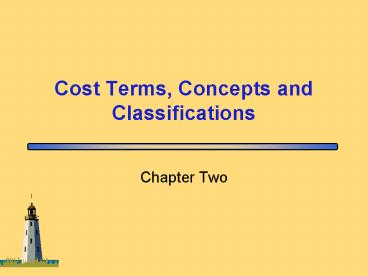Cost Terms, Concepts and Classifications - PowerPoint PPT Presentation
1 / 38
Title:
Cost Terms, Concepts and Classifications
Description:
Example: Wages paid to automobile assembly workers. 2-6 ... Distinguish between product costs and period costs and give examples of each. 2-9 ... – PowerPoint PPT presentation
Number of Views:102
Avg rating:3.0/5.0
Title: Cost Terms, Concepts and Classifications
1
Cost Terms, Concepts and Classifications
- Chapter Two
2
Learning Objective 1
Identify and give examples of each of the three
basic manufacturing cost categories.
3
Manufacturing Costs
The Product
4
Direct Materials
- Raw materials that become an integral part of
the product and that can be conveniently traced
directly to it.
Example A radio installed in an automobile
5
Direct Labor
- Those labor costs that can be easily traced to
individual units of product.
Example Wages paid to automobile assembly
workers
6
Manufacturing Overhead
- Manufacturing costs that cannot be traced
directly to specific units produced.
Examples Indirect labor and indirect materials
7
Non-manufacturing Costs
8
Learning Objective 2
Distinguish between product costs and period
costs and give examples of each.
9
Product Costs Versus Period Costs
- Product costs include direct materials, direct
labor, and manufacturing overhead.
- Period costs include all selling costs and
administrative costs.
10
Quick Check ?
- Which of the following costs would be
considered a period rather than a product cost in
a manufacturing company? - A. Manufacturing equipment depreciation.
- B. Property taxes on corporate headquarters.
- C. Direct materials costs.
- D. Electrical costs to light the production
- facility.
- E. Sales commissions.
11
Quick Check ?
- Which of the following costs would be
considered a period rather than a product cost in
a manufacturing company? - A. Manufacturing equipment depreciation.
- B. Property taxes on corporate headquarters.
- C. Direct materials costs.
- D. Electrical costs to light the production
- facility.
- E. Sales commissions.
12
Classifications of Costs
- Manufacturing costs are oftenclassified as
follows
DirectMaterial
DirectLabor
ManufacturingOverhead
13
Comparing Merchandising and Manufacturing
Activities
- Merchandisers . . .
- Buy finished goods.
- Sell finished goods.
- Manufacturers . . .
- Buy raw materials.
- Produce and sell finished goods.
14
Balance Sheet
- Merchandiser
- Current assets
- Cash
- Receivables
- Prepaid Expenses
- Merchandise Inventory
- Manufacturer
- Current Assets
- Cash
- Receivables
- Prepaid Expenses
- Inventories
- Raw Materials
- Work in Process
- Finished Goods
15
Balance Sheet
- Merchandiser
- Current assets
- Cash
- Receivables
- Prepaid Expenses
- Merchandise Inventory
- Manufacturer
- Current Assets
- Cash
- Receivables
- Prepaid Expenses
- Inventories
- Raw Materials
- Work in Process
- Finished Goods
16
Learning Objective 3
Prepare an income statement including calculation
of the cost of goods sold.
17
The Income Statement
- Cost of goods sold for manufacturers differs
only slightly from cost of goods sold for
merchandisers.
18
Basic Equation for Inventory Accounts
19
Learning Objective 4
Prepare a schedule of cost of goods manufactured.
20
Schedule of Cost of Goods Manufactured
Calculates the cost of raw material, direct labor
and manufacturing overhead used in production.
Calculates the manufacturing costs associated
with goods that were finished during the period.
21
Product Cost Flows
As items are removed from raw materials inventory
and placed into the production process, they
arecalled direct materials.
22
Product Cost Flows
23
Product Cost Flows
All manufacturing costs incurred during the
period are added to the beginning balance of work
in process.
24
Product Cost Flows
Costs associated with the goods that are
completed during the period are transferred to
finished goods inventory.
25
Product Cost Flows
26
Manufacturing Cost Flows
Income StatementExpenses
Balance
Sheet Costs
Inventories
27
Learning Objective 5
Understand the differences between variable costs
and fixed costs.
28
Cost Classifications for Predicting Cost Behavior
- How a cost will react to changes in the level
of activity within the relevant range. - Total variable costs change when activity
changes. - Total fixed costs remain unchanged when activity
changes.
29
Variable Cost
- Your total long distance telephone bill is
based on how many minutes you talk.
30
Variable Cost Per Unit
- The cost per long distance minute talked is
constant. For example, 10 cents per minute.
31
Fixed Cost
- Your monthly basic telephone bill probably
does not change when you make more local calls.
32
Fixed Cost Per Unit
- The average fixed cost per local call decreases
as more local calls are made.
33
Cost Classifications for Predicting Cost Behavior
34
Quick Check ?
- Which of the following costs would be variable
with respect to the number of cones sold at a
Baskins Robbins shop? (There may be more than
one correct answer.) - A. The cost of lighting the store.
- B. The wages of the store manager.
- C. The cost of ice cream.
- D. The cost of napkins for customers.
35
Quick Check ?
- Which of the following costs would be variable
with respect to the number of cones sold at a
Baskins Robbins shop? (There may be more than
one correct answer.) - A. The cost of lighting the store.
- B. The wages of the store manager.
- C. The cost of ice cream.
- D. The cost of napkins for customers.
36
Learning Objective 6
Understand the differences between direct and
indirect costs.
37
Assigning Costs to Cost Objects
- Direct costs
- Costs that can beeasily and conveniently traced
to a unit of product or other cost object. - Examples direct material and direct labor
- Indirect costs
- Costs that cannot be easily and conveniently
traced to a unit of product or other cost object.
- Example manufacturing overhead
38
End of Chapter 2































